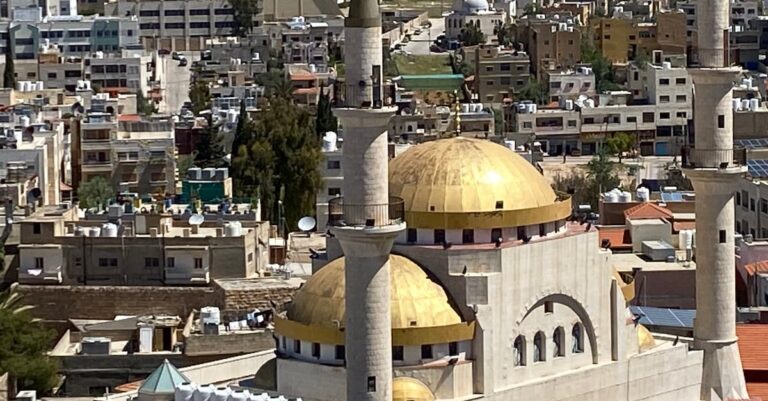
We are reader-supported and may earn a commission on purchases made through links in this article.
The Kingdom of Jordan in recent years has evolved into such a popular Middle Eastern destination that people traveling through the country have unintentionally paved a tourist trail from north to south.
The first stop on the typical path through Jordan is the capital city of Amman, where people fly into the airport and then base themselves for a few days in order to explore the northern part of the country.
Just south of Amman, though, is a charming little city called Madaba. Nicknamed the City of Mosaics because it holds a wealth of this ancient art form, Madaba recently has transformed itself into as welcoming a destination as the capital city.
Best Tips & Tools to Plan Your Trip
In addition to its mosaics which have drawn day trippers here for years, it is now also home to dozens of hotels, restaurants and shops for visitors to enjoy. Fortunately, this transformation has not caused Madaba to become overtouristed; rather, it has made it a more inviting place for travelers to stay for more than just a few hours.
I’ve witnessed this transformation, seeing Madaba go from a little city filled with mosaics and not much more to a thriving Jordanian tourism
destination in just a few years. In this guide to Madaba, Jordan I’ll tell you exactly what this enchanting city now has to offer so you can decide how long you want to stay and how to best spend your time once you arrive.
Ancient and Modern Madaba
Madaba has existed since biblical times, dating back to at least 1300 B.C. In the Bible, it is called Medeba. The ancient city of Madaba still exists but is now buried beneath the modern city of Madaba. Approximately 70,000 people live there today.
Where is Madaba, Jordan?
Madaba is located in central Jordan, about 22 miles south of Amman and 135 miles north of Petra.
How to Get to Madaba, Jordan
You can easily travel to Madaba from anywhere in Jordan via private car, taxi, Uber or minibus. There are no trains or any other form of transportation to or from Madaba.
How to Get around Madaba, Jordan
Madaba is a small, very walkable city with good sidewalks and good signage in Arabic and English. If you’re not up to walking everywhere, don’t worry.
You can find plenty of taxis on the streets. It may be a bit of a hassle to get the taxi drivers to use their meters, though, rather than just trying to charge you whatever they want to charge. If you wish to avoid this, you can use the Uber or Careem apps to find drivers.
When Is the Best Time to Visit Madaba, Jordan
The best time of year to visit Madaba depends on you and your weather preferences.
The warmest weather in Jordan is from May through October, with the hottest month of August averaging 94 degrees Fahrenheit.
The primary rainy season goes from November through March, although each of those months only average rain for a handful of days.
For most people, the spring months of April and May as well as the autumn months of September and October are the best times to visit Madaba, as these months experience the mildest temperatures and the least chance of rain.
Where to Stay in Madaba, Jordan
Madaba has almost two dozen hotels, most of them small and privately owned. These are located all over the city, from several on the main tourism
streets in the northern end to St. John Hotel on the opposite end of the city away from the touristy area.
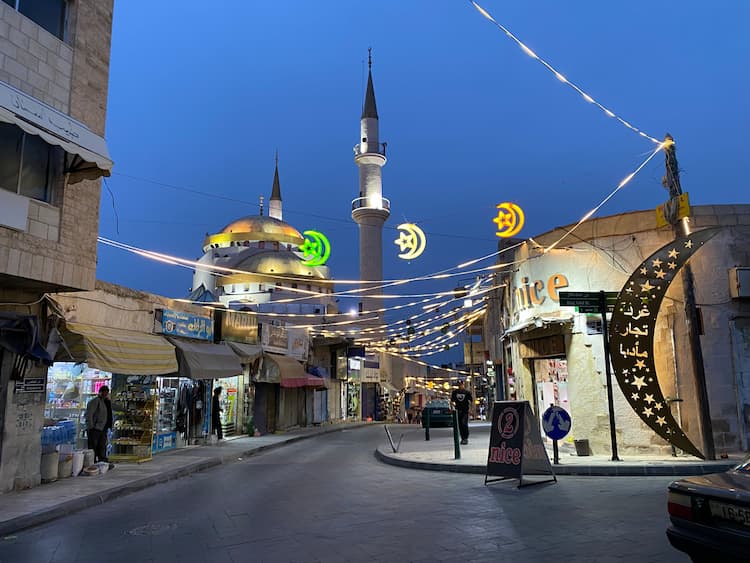
Where to Eat in Madaba, Jordan
The increase in the number of restaurants in Madaba is one recent development that really helps make this destination very comfortable for travelers nowadays. You can choose from approximately 30 different restaurants located throughout the city, serving both local and international cuisine.
The Famous Mosaics of Madaba, Jordan
Mosaics are what draw most people to Madaba. If you’re a mosaic aficionado like me, you are going to love Madaba. Most of its mosaics were created during the Byzantine period, while others are from more modern times. All of them are amazing. These are the five locations in Madaba where you can see the mosaics for which the city is famous.
St. George Church
St. George Church is the most-visited sight in Madaba. That is because it is home to the famous Mosaic Map. This map is perhaps the most unique mosaic you will ever see.
Composed of more than a million bits of tiny multi-colored stone, this mosaic measures 34.5 feet x 16.5 feet, is located on the floor of the church’s apse and depicts the Holy Land of ancient days – Israel, Egypt, Lebanon and, of course, Jordan.
It dates back to the 6th Century A.D. and is believed to have been created by the Christian community of that era. This is the oldest-known map of the Holy Land still in existence today and, before the arrival of modern-day cartography, was also known as the most accurate map of the Holy Land.
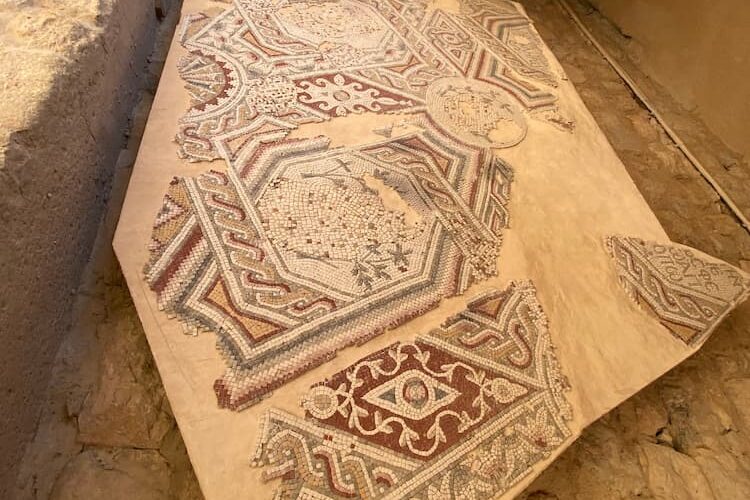
Madaba Archaeological Park
The Madaba Archaeological Park is a must-see, with ruins from Roman times and a wealth of well-preserved Byzantine mosaics. It’s divided into two sections, one on each side of a street near St. George Church.
In the western side of the park, you’ll find the Church of the Holy Martyrs, built in the 6th Century A.D. You’ll also find the Burnt Palace, a Byzantine royal residence which gets its name because it, along with its mosaics, was badly burned in a fire likely resulting from an earthquake in 747 A.D.
The eastern side of the archaeological park contains a Roman street and ruins of the Virgin Mary Church. Here you’ll also find the Crypt of St. Elias, which was built on top of another church that was destroyed in the earthquake. You’ll also find Hippolytus Hall, which contains a rare mosaic depiction of a myth.
This side of the Madaba Archaeological Park is also the home of Jordan’s oldest known mosaic fragment.
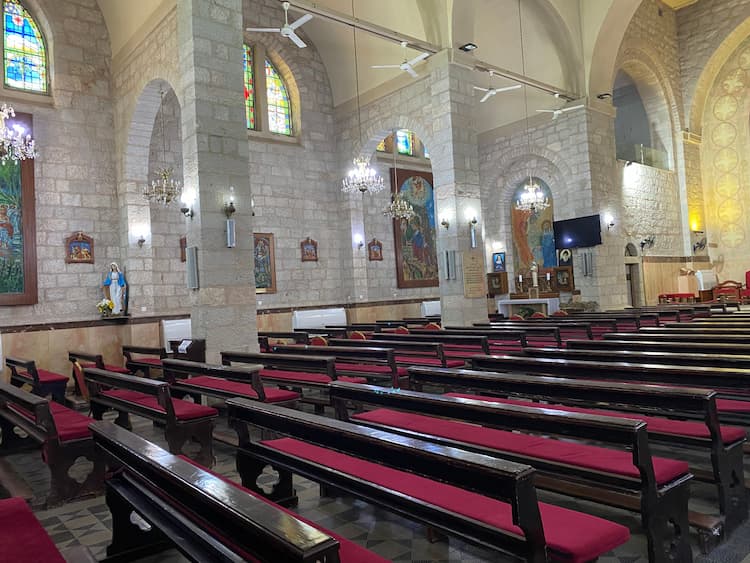
St. John the Baptist Church
St. John the Baptist Church is underrated. That is primarily because it’s overshadowed in popularity by the Mosaic Map in St. George Church. No matter how much time you decide to spend in Madaba, though, you should not miss St. John the Baptist Church.
Built on a hilltop on the southern side of Madaba in 1913, this is a Roman Catholic church with many large mosaics depicting scenes from biblical history displayed on the walls of its nave. What is really outstanding about this church, though, is what is beneath it and what is above it.
Go down a flight of stairs just outside of the nave, and you’ll find yourself walking through a sort of underground stone museum consisting of several rooms of mosaics as well as figures dressed in period costumes depicting scenes from ancient Jordanian life.
If you’re up for climbing several flights of various types of steps, including a metal winding staircase, you can go out on the rooftop of the church. Here you’ll be able to enjoy a stunning panorama of Madaba and the surrounding area.
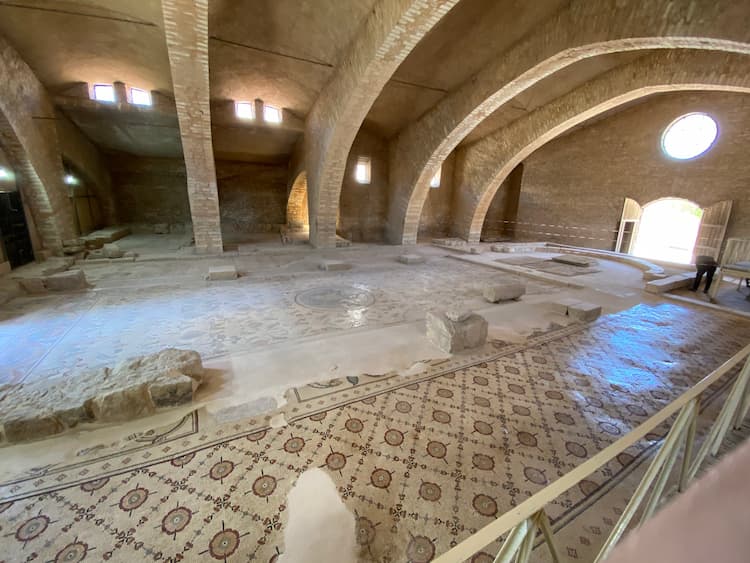
Church of the Apostles
Located not far from St. John the Baptist Church is the Church of the Apostles. This is one of Madaba’s oldest churches, but it was not discovered until the 20th Century.
The exterior of the Church of the Apostles looks rather plain and boring but has an interesting origin, as it was built from ruins of old homes in the city.
The church is known for its expansive mosaic floor, one of the region’s largest and most intact mosaic floors, which depicts scenes from the sea along with Byzantine writing. One of these mosaics has proven quite useful, in that it indicates exactly when the church was built – 578 A.D.
Madaba Museum
The Madaba Museum was established after mosaic floors were discovered inside several of the city’s ancient homes. This is an indoor/outdoor museum consisting of three separate areas.
The first area you’ll see when you arrive at the Madaba Museum is the outdoor section which is filled with mosaics from the homes around which the museum was established as well as pieces of columns and niche stones from the Late Bronze Age.
The other two areas of the museum are indoors. Inside the Madaba Archaeological Museum you’ll view pottery, mosaic panels, coins and other artifacts from ancient times. In the Madaba Folklore Museum you’ll discover what traditional clothing and jewelry looked like in the Jordan of long ago.
All of the five mosaic sites are within walking distance of each other, and they are situated in two different locations in the city.
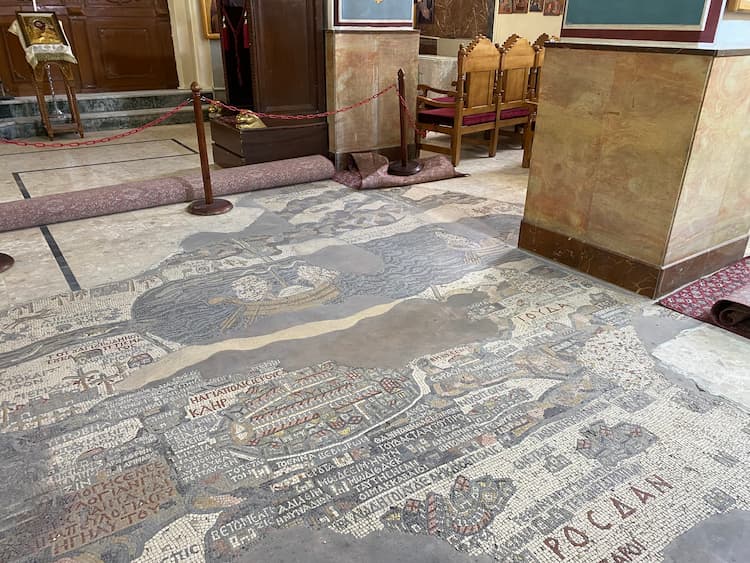
St. George Church and the Madaba Archaeological Park are on the northern side of the city near the Visitor’s Center and tourism streets.
St. John the Baptist Church, the Apostles Church and the Madaba Museum are all in roughly the same area of the opposite part of the city.
It takes only approximately 10 to 15 minutes to walk from the mosaics sites in the northern part of the city to the mosaics sites in the southern part of the city.
What Else to See and in Madaba, Jordan
While the famous mosaics are Madaba’s main attraction, you can easily find many other sights to see and things to do while you’re in town.
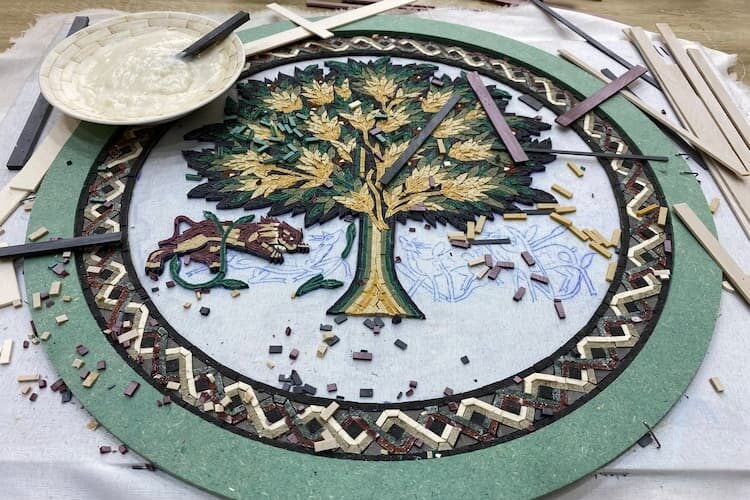
Mosaics Workshops
In Madaba, you can not only see incredible mosaics – you can watch mosaic artists create them too. Take a walk on the narrow streets near the Visitor’s Center and you’ll come across several small mosaics shops scattered about,
with local artists hard at work on their craft. Feel free to go inside and watch. They may even invite you to sit down and work on their mosaics with them.
Handicraft Shops
Stroll the streets near the mosaics workshops and you’ll find there’s no shortage of little shops to browse and souvenirs to buy, many of them handmade.
Rooftop Views
You don’t have to walk up several difficult flights of stairs in St. John the Baptist Church in order to enjoy picturesque rooftop views of Madaba and the surrounding countryside (although the church’s views are honestly the best). Some of Madaba’s hotels and restaurants have lovely views of their own.
St. John Hotel, just a two-minute walk down the street from the church, is my personal favorite. On their rooftop you’ll find not only incredible views; at night inside the restaurant on the roof you can find local people gathered for tea and shisha. On the other side of the city you can enjoy rooftop views as well such as at Bawabit Restaurant, which also offers outdoor rooftop dining.
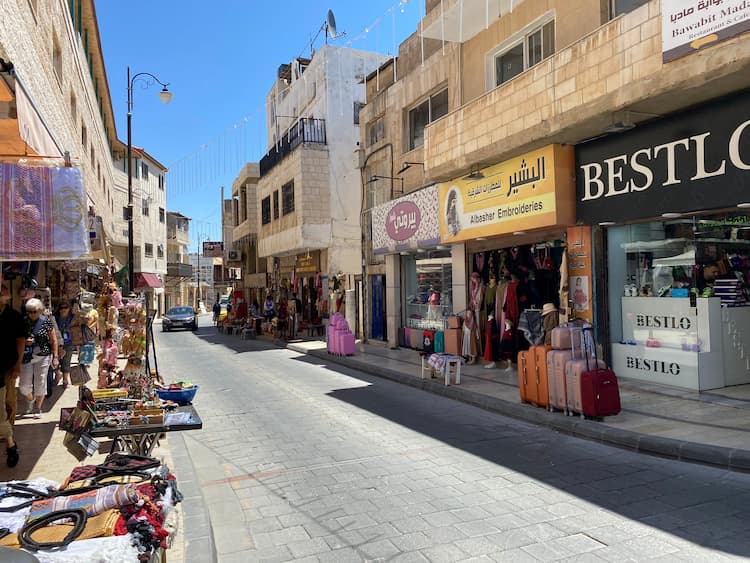
Madaba City Mall
Visiting local malls in foreign locations gives you a glimpse of local life you may not get any other way. If you like people and you like shopping, you should check out the Madaba City Mall. Here you’ll be able to hang out amongst the locals and perhaps even buy some of Jordan’s current fashion.
Madaba has worked hard to become not just a day trip from Amman but a destination in its own right, and it has succeeded.
Travelers to Madaba today experience an enjoyable and easy time, with just the right mix of things to see and do as well as places to stay and food to eat, whether visiting for a few hours or a few days. Keep your eye on Madaba. This could be the next big destination in Jordan.
If you go:
You may want to buy the Jordan Pass https://www.jordanpass.jo/ before traveling to Madaba. It will cover the cost of your tourist visa to enter the country and get you into about 40 sights throughout the country as well, including most of the mosaic sites in Madaba. The 100 USD it costs is more than worth it.
Inspire your next adventure with our articles below:
Author bio: Sabina Lohr is a freelance writer focusing primarily on the Middle East. She shines a unique light on the lesser-known places of the region as well as the perspectives and lives of the people who call this region home. She’s been widely published in numerous print and online magazines including National Geographic’s Intelligent Travel Blog, Afar, Destinations of the World News and PortHole Cruise Magazine.
- Palawan Perfection: Exploring the Philippines’ Last Ecological Frontier - July 13, 2025
- A Journey to Ashland, Oregon’s Shakespeare Festival - July 13, 2025
- The Ultimate Guide to Cairo’s Top Three Museums: Which Should You Visit? - July 12, 2025

